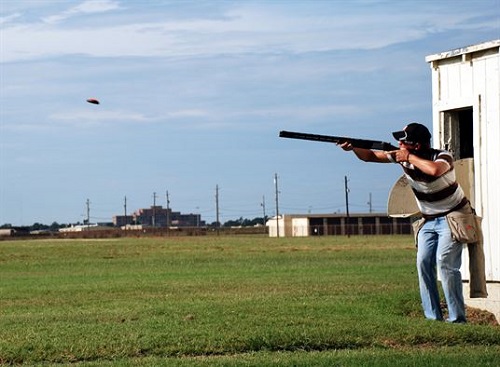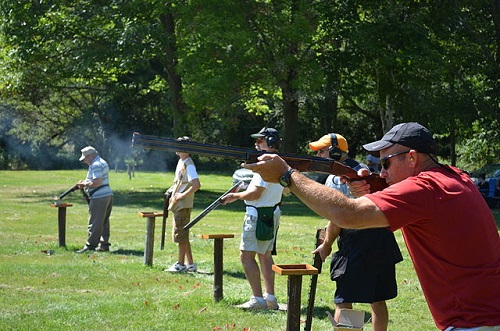Difference between Skeet and Trap
Clay target shooting is a shooting sport which is divided into categories such as:
- Skeet shooting
- Trap shooting
- Sporting shooting
Even though the sport has a variety of disciplines, these three are its main pillars. This article will mainly focus on skeet and trap shooting.
What is Skeet and Trap shooting?
Clay target shooting, also known as Inanimate Bird Shooting, is a competitive sport that requires the shooting of a firearm (usually a shotgun) at special targets which are flying.
The sport has multiple categories because different rules apply to different disciplines, but these categories can be divided into three main groups.
These are skeet, trap and sporting shooting.
History of the sport
Clay target shooting has been around for hundreds of years and has, in time, developed considerably. It is a common and widely practiced sport, especially in the USA, New Zealand, Australia and England.
Initially the sport was a method for hunters to keep active off season, but it has evolved into a popular competitive sport.
The terminology used to refer to the sport and its manifestation dates to earlier times when live birds were the target.
The practice of shooting living birds was made illegal worldwide around 1920s. The target was eventually replaced with a clay object, called a clay pigeon.
Skeet and Trap shooting have been included in the Summer Olympic Games since 1886. In early 1900s the living pigeon was removed and replaced by the clay pigeon.
The target
The original targets for clay shooting sport were live pigeons that were released from boxes or hats. Eventually glass balls were added in to supplement the animated targets.
In 1880 George Ligowsk invented the clay pigeon which is still used as a target today. The main reason for Ligowsk’s invention seems to have been the difficulty of providing enough live pigeons.
Clay pigeon targets are shaped like an inverted saucer. They are made from a mixture of chalk and pitch. The target is designed to withstand being launched from a station but to also shatter into pieces when hit by the shooter. They come in variety of colors but the most used ones are either fluorescent orange or black.
Because the sport is based on the shooting of live birds, the targets must fly in a pattern and at a speed that mimics that of a released bird.
Skeet Shooting
Description
Skeet is the shooting of targets launched from two posts. The participants in skeet usually use a shotgun to shoot the clay pigeon.
The set-up is typically in a field and there are eight stations, which are all numbered. The exercise usually unfolds within a group of five shooters, who move around a semi-circular field between the stations in a sequent manner.
Two machines release targets. A low house releases the targets from three feet off the ground while a high house releases the targets from ten feet off the ground.
The target moves at approximately 72 km per hour and at a variety of angles.
Each participant first shoots at a target originating from the low house, then a target originating from the high house.
A common practice in Skeet is double shooting. In this case, targets are released from both houses simultaneously and the shooter must fire two shots. The double release of the target is usually only done at four out of the five stations.
A round of skeet includes twenty-five shots.
Trap Shooting
Description
Trap shooting dates to the 18th century and it is the oldest practiced shotgun sport in the USA. It is one of the most popular disciplines in competitive Clay Shooting.
In Trap, shooters stand in a line and aim at targets which are launched from a station placed partially underground.
The target is released at a speed of approximately 65 km per hour and usually moves away from its release point.
In Trap, there are five stations and the same number of shooters who alternate their positions so that they complete a firing from each target.
There are three different events in Trap. These are:
- Singles
- Doubles
- Handicap
In Singles, one clay bird is released from the station, in Doubles two clay birds are released simultaneously and in Handicap one bird is released but from various distances.
Each shooter has 25 rounds which means they will shoot five times from each station.
The differences between Skeet and Trap Shooting
Skeet shooting has eight stations while Trap has five.
In Trap, the participants shoot five times from each station while in Skeet, they move clockwise to each station and take their shots, based on how many targets are released.
In Skeet shooting there are two machines above ground that release targets from different heights. In Trap, the targets are released from almost underground level.
In Trap, the targets usually move away from the shooter while in Skeet, they move either towards or away from the shooter.
In Skeet shooting the clay target moves at a speed of approximately 72 km per hour and in Trap shooting it moves at around 65 km per hour
There are two procedures in Skeet and three in Trap.
| Skeet Shooting | Trap Shooting |
| There are eight shooting stations in Skeet. | There are five shooting stations in Trap |
| The participants take two shots from all the stations, and three from four out of the five. | The participants take five shots from each station. |
| There are two machines that release targets from different heights. | There is one machine that releases targets, situated very closed to the ground. |
| The clay target moves at a speed of approximately 72 km per hour | The clay target moves at a speed of approximately 65 km per hour |
Summary Points
Trap and Skeet shooting are both subcategories of Clay Pigeon Shooting. They have both been around for hundreds of years and have progressed a lot since then. From being a training exercise for hunters to keep fit off the hunting season they are now both Olympic and competitive sports.
In the beginning, live birds were used as targets but in the late 1800s the clay target was introduced and by early 1900s the use of live birds was declared illegal across the world.
The two shooting sports have some obvious similarities but different rules and procedures apply to each.
- Difference between Skeet and Trap - October 11, 2017
- Difference between Real Image and Virtual Image - September 30, 2017
- Difference between Latin America and South America - September 29, 2017
Search DifferenceBetween.net :
6 Comments
Leave a Response
References :
[0]“Beginner's Introduction to a Truly American Shotgun Game.” Beginner's Introduction to Skeet, www.scskeet.com/Beginner_skeet/Beginner_Skeet.htm
[1]INFOGRAPHIC: Trap vs. Skeet vs. Sporting Clays." OutdoorHub. N.p., Nov. 2016. Web. 29 Sept. 2017.
[2]Newcomb, Horace. "Target practice: A Batesonian “field” guide for communication studies." Journal of communication 43.3 (1993): 127-132.
[3]"Trap Basics." Carney Rod and Gun Club Homepage. N.p., n.d. Web. 04 Oct. 2017.
[4]“Trap Talk.” Shooting Sportsman, 23 May 2016, shootingsportsman.com/trap-talk/. Accessed 29 Sept. 2017.
[5]Image Credit: http://www.sheppard.af.mil/News/Article-Display/Article/369329/sheppard-hosts-skeet-shoot-tourney/
[6]Image Credit: https://commons.wikimedia.org/wiki/File:A_typical_%22American%22_trap_shoot_scene.jpg



A very informative document. Exactly what I was looking for.
Many thanks
Explained perfectly. Quite new to this and now I can have the terminology correct. Thanks
There are some inaccuracies in this article.
Skeet targets never change angles and doubles are shot at 4 out of 8 of the stations, not 4 out of 5. Also, whether you shoot the low house first or the high house depends on which station you are on.
Trap targets change angles. The machine osculates.
I stopped reading after that…
Where did you read that?
Aside from the few inaccuracies cited by the purist, I thought the info was very beneficial to the newcomer. Thanks for the great explanation. I really look forward to getting into this exciting sport.
These are some great things on difference between skeet and trap that you have discussed here. I really loved it and thank you very much for sharing this with us. You have a great visualization and you have really presented this content in a really good manner. I found this Realcountry.co.nz Having loads of data, if possible do have a look.